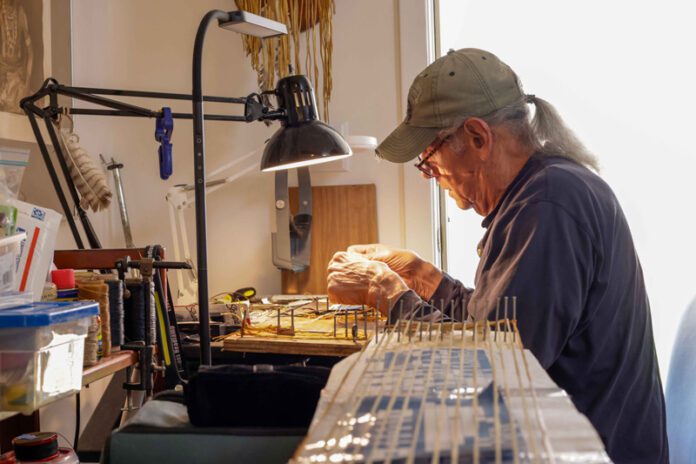In an engrossing new exhibition at the M.V. Museum, we learn how Wampanoag tribal history, memory, identity, artistry, and cultural traditions echo throughout the generations of a single family.
The show, “Generations: A Legacy of Art and Culture,” on view through February 23, centers on an extraordinary wampum belt by Aquinnah Wampanoag tribal elder Donald “Slender Birch” Widdiss. It serves as a jumping-off point to highlight the creations of three generations of Widdiss family artists: the stunning pottery fashioned from the multicolored clay of the sacred Gay Head Cliffs made by Donald’s mother, Gladys, and his son Heath, and wampum crafted by Donald and his son Jason.
Chief Curator Bonnie Stacy shared about the impetus for commissioning the belt. “We’d been talking about adding more contemporary Wampanoag work to the collection for quite a while. We wanted something special, to get a museum-quality piece. Berta Welch, who is on the Museum’s collections committee, got us in touch with Donald, and through the course of the conversations, we were talking about what we might want. He suggested a belt that would tell a story. We decided that was exactly what we wanted to do. He’s very creative, and we thought it would be a very good partnership.”
Walking into the exhibit, the strikingly bold and simultaneously complex belt immediately draws your eye. He crafted the beads from quahog shells, designed a handsome pattern for the some 25-inch-long piece, and carefully strung each of the 1,599 beads into place over countless hours of work and a lifetime of experience.
The belt tells the story of Noepe (Martha’s Vineyard) and the Wampanoag people, starting with the creation of the Island and Moshup, the giant who formed it. Among other details are references to Noepe’s six towns and sailing vessels representing whaling and the arrival of commerce and tourism. At the end is a striking eagle, marking the federal recognition of the Tribe in 1987.
The belt, however, resonates with meaning beyond its visual depiction. In a fascinating film by Indaia Whitcombe, Donald explains while working, “Each bead is telling part of the story of the belt. It’s not a graphic element. It’s an emotional element that is represented graphically. I have to make this belt speak.”
Jason “Strong Deer” learned to make wampum from his father. He says, “This is my contribution to my culture that has been passed down from previous generations. I don’t dance, sing, or play tribal drums — my part in honoring my culture is making wampum.”
Donald’s mother, Gladys “Wild Cranberry” (Malonson) Widdiss (1914-2012), was a respected tribal elder, historian, educator, and leader. She began making and selling pottery to tourists as a child and continued refining and perfecting her craft throughout her long life.
Gladys harvested her material from the sacred Gay Head Cliffs, which is prohibited to anyone who is not Wampanoag. Once asked what her pots meant to her, she responded, “When I work in clay, I’m home.” Her pieces were far more than a means to making money but, rather, a way to connect with the land her people called home for countless generations.
In the show’s oral history recordings, Gladys recalls learning how to craft pottery by mimicking her mother and hauling the clay up from the cliffs in burlap bags. She also speaks about the complex steps for making her wares, including gathering, drying, processing, cutting, and then combining the different-colored clays.
On display are pots by Gladys and her grandson, Heath “Strong Fox” Widdiss. Each with unique waves of red, terracotta, gray, and white that recall the Aquinnah Cliffs. Gladys formed her pieces by hand and dried them in the sun because a traditional kiln fades the natural colors. Heath devised a way to create his on a potter’s wheel and applies a clear coating that makes the distinct colors within each piece shine. With their work side by side, we see the visual link between the generations.
Looking around the exhibit, whether at the wampum or pottery, we see how these artistic expressions are interconnected links both of and to the land the Widdis family and their ancestors have called home for thousands of years.
“Generations: A Legacy of Art and Culture” is on view through Feb. 23, 2025. For more information, visit mvmuseum.org/exhibition/generations.




